If you were to ask me how I would define “minimalist” when it comes to running footwear, I would say that there are four factors that are most critical:
1. A minimalist shoe should be lightweight – in fact, the lighter, the better. My personal rule of thumb is to look for shoes that weigh 10oz or less each, and many of my shoes now weigh in at under 8oz.
2. A minimalist shoe should not have a lot of structure to the upper – a layer of fabric/mesh sufficient to hold it on your foot is all that’s needed (the original Nike Free 3.0 is a great example of this).
3. A minimalist shoe should not have a thick, heavily cushioned heel. The best example of this is the Vibram Fivefingers, which have virtually no cushioning in the heel, and no heel-forefoot drop.
4. A minimalist shoe should be as flexible as possible to let the foot move and flex naturally. Again, both the Nike Free 3.0 and Vibram Fivefingers accomplish this well.
A fifth, and more practical rule that I believe in is that a minimalist shoe should never cost more than $100. The word minimalist in and of itself implies less of a shoe, and for that reason I can’t understand how any “stripped-down” shoe should cost more than one that is loaded with the supposedly “latest and greatest” shoe technology. Given that many people are interested in trying minimalist running, but are not necessarily ready to shell out the bucks for a pair of shoes that they might not wind up wearing very often, what options are out there?
I would argue that in many ways, almost every major shoe company already makes minimalist footwear in the form of spikeless cross-country racing flats. Of the four criteria I list above, XC flats fulfill the first 3 almost perfectly. They tend to be very lightweight, they have very minimal structure in the upper, and they tend to have only a very small amount of cushioning in the heel. I own two pairs of XC flats – the Saucony Kilkenny 3 spikeless and the Brooks Mach 11 spikeless, and in both cases the heel is very thin. In the Brooks Mach 11 it appears to the naked eye that the heel might actually be slightly thinner than the forefoot, and while walking and running in them I get a distinct sense that my forefoot is being emphasized when it comes to ground contact (it’s a difficult sensation to describe unless you try it, it feels similar to the way Newton shoes feel). Where the XC flats don’t exactly measure up to my minimalist criteria is in their flexibility – they tend to have a fairly rigid sole (certainly more rigid than the Vibrams or Free’s), but hardly moreso than most more typical running shoes.
Perhaps the best thing about cross country flats is that they’re really cheap as shoes go. Most of the major shoe manufacturers make them, and in most cases you can buy a pair for under $60. If you’re considering giving them a try, sizing can be an issue – they tend to run small and on the narrow side. That being said, I by no means have narrow feet, and both the Saucony Kilkenny 3 and Brooks Mach 11 fit my foot well. I wear a size 10 in running shoes, and I had to order 1/2 size up in the Saucony’s. The Brooks Mach 11 fits true to size for me, and is a very comfy shoe (I’ll be doing a full review of the Brooks Mach 11 in the near future).
As with any other more minimalist shoe, you’ll probably want to give yourself a break-in period if you decide to try a pair of XC flats. The minimal amount of cushioning is noticeable and can lead to a greater sensation of impact until your stride adjusts, and the low heel means that you’ll probably deal with some calf soreness after your first few runs in them. However, if you use caution and common sense, I see no reason why you can’t incorporate a cross country racing flat into regular training – in fact, I know of a few runners who use them almost exclusively.
So, if you’re looking for a minimalist running shoe and don’t want to spend a bundle to try it out, I’d highly recommend giving an XC flat a try – just make sure you get the spikeless version or else you wont be doing much running on asphalt or concrete!.
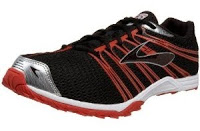

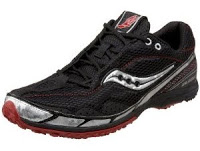
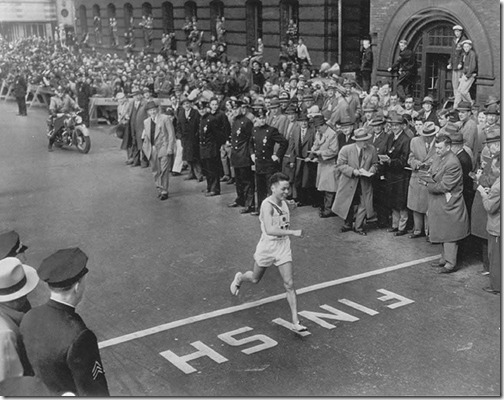
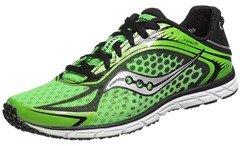
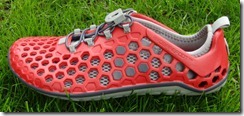
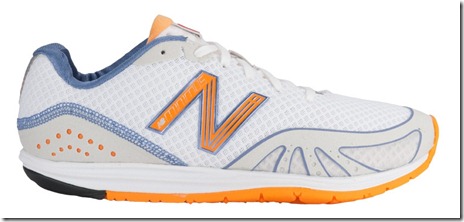
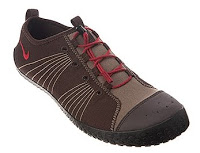














I’m totally with you – the only time I wear any heavier shoes is when I need
my Gore-Tex trail shoes (La Sportiva Wildcat GTX) due to snow/ice/heavy
rain. It’s amazing what a difference a few ounces can make. I’ve also heard
good things about those New Balance 100’s.
Pete
Hi, Peter,
Thanks for all the useful reviews and commentaries on the various shoes. Based on your suggestion I bought the Brooks Mach XI. I have run in them twice (about 4 miles each time) and found them to be light and fast. I am thinking about using them for a 10K road race. Any thoughts about whether that would be a good idea? I have run my most recent road races (from 10K to marathon distances) in Asics Gel Speedstar, but am looking for something with a lower profile. Many thanks for any feedback you can provide. Best regards, Nils (in DC area)
Nils,
Thanks for the comment! I’ve run up to 10 miles in the Mach 11, and
have also done some speedwork in them. I wouldn’t hesitate to use them
in a 10k myself, but we’re all different, so it’s hard to say what
might be best for you. Listen to your body is probably the best advice
I can give – if you do some speedwork in them without a problem, then
you can decide if they’ll work in the race.
Pete
Sent from my iPod
Great stuff all around here. I’ve logged 100’s of miles on a couple of sets of Asics Piranhas, but I’m looking for a cheaper replacement. I think I’ll give the two spikeless flats you suggest a try. The price is right.
I’m liking the new Mach 12 a lot!
Pete
I’m a new barefoot / minimalist runner coming into my first Canadian winter soon, and I had hit on this idea as well. I had further wondered about getting a shoe with removable spikes to use when snow and ice cover the roads I run. Any thoughts on this? Seems to me this would be an inexpensive option for minimalism and winter traction at the same time. Do you think spikes would work well on snow and ice?
Don’t see why it wouldn’t work, especially if you are a forefoot
runner. I’d just be wary of using them on roads with the spikes.
Yaktrax work well.
Pete
Thanks for the reply! I wore out two pairs of Yaktrax last winter, which is why I’m digging around for other possibilities. Thanks again, Pete.
Stabilicers is another brand – have a pair but haven’t tried them yet.
I also have La Sportiva hobnails that I screwed into an old pair of
shoes – they work well but are pricy.
Pete
Miranda, If you purchased the XC spikes for winter running. I would be interested to hear how it went. We don’t get as much winter in Kansas, but I had considered getting the Spiked version of the Shays for that and for the occasional XC race.
how are the XC shoes as far as durabilty and traction on pavement?
I run mostly roads with mine and they have done fine. And for the price, you
could buy two pairs for the price of most regular shoes.
Pete
First, I’ve enjoyed what I’ve read of your blog. I thought that I would add a comment here since I have some experience with XC flats.
I’ve been wearing Saucony Shay XC flats almost exclusively for about a year.I’ve run in them on gravel, on pavement, on trails, and raced a half marathon.
On gravel: They are great. I might caution people who are not used to gravel about trying these on gravel. When I first moved to the country, I would get stone bruises through even heavily cushioned trainers. Now, I do not get a stone bruise from gravel roads even if I strike a stone with the arch of the Shays which is only protected by the mesh upper. (I feel pain — sometimes a sharp pain, but it has no lingering effects.) I do most of my running on gravel and these are currently my favorite shoe for that purpose.
On Paved roads: I need to experiment again with longer runs on paved roads. Generally, I do about 1/3 of my running during the work week on pavement running to and from work. They work fine for that. Last spring, I had some issues when I was doing long runs on paved trails with friends. But, those issues may well have been more due to trying to increase mileage and/or intensity too quickly rather than due to the shoes. It may also be the case that I needed to spend more time running in the Shays before running such distances on roads.
On trails: The Shays worked well for a couple of trail runs where I was running more tentatively over the rocks since I was new to trail running. But, when I started getting confident and moving more quickly, I stepped on a large rock on the unprotected arch and incurred a deep bruise that troubled me for a week or two. I have since retired them from trail running.
Racing: At the time I bought the Shays, I also purchased a pair of Adizero Pro flats (which I also like). My first race after that purchase was a winter half marathon that covers four miles of gravel. I’d been training on gravel in the Shays for about 1.5 months and decided to wear those for the half marathon rather than the Adidas flats because of that gravel portion which was also likely to be snowy/icy. They worked great and I would have run in they Shays again this year if I had run that race. In general, however, I think that it is worthwhile to have a road flat for road races. The Shays seem durable enough on pavement, but I feel that the road flats provide better traction on pavement. I wouldn’t race in the Shays unless there’s a good portion of the course that will be on something other than pavement (such as miles 9-12 of a half marathon).
Overall I like running in the Shays. After I wore out the first pair, I purchased two more and I have been alternating between the two each day.
Thanks for your thoughts! Curious – how are the Shay’s in terms of forefoot
width? My biggest problem with most XC shoes is that they tend to be narrow.
Pete
Actually, they do crowd the small toe a bit. It would be nice if the forefoot were a bit roomier. That seems to be a common problem with spikes and some racing flats. I do have a narrow foot, so I actually appreciate the narrowness through the mid-foot. It would be nice if they allowed room for toes.
Pete,
Love this site- lots of great info. I have Kinvaras soon retiring (feel to bulky after lots of time in VFF TrekSports). I am looking at Mach 12, A4 and Kilkenny for options for longer runs, half and full and 50k.
I fit a 8.5 with some extra room (length) in Kinvara. Any sizing suggestions for Kilkenny, A4, and mach 12?
Thanks.
All of those will fit narrower than the Kinvara, so be aware of that.
Kilkenny does not fit me well, others are better. A4 will be most
similar to the Kinvara. Also take a look at the Merrell Trail Glove
and the New Balance Minimus options.
Pete
On Monday, February 28, 2011, Disqus
Just bought a pair of Kilkenny xc 4 flat of ebay believing I could insert spikes into them. They are extremely small in size however that aside wondering would my daughter be able to wear them for xc even without the assistance of spikes.
They make the Kilkenny in both spiked and spikeless versions. If there are no spots to screw the spikes in, then you have the spikeless version. How well they will work depends on courses and conditions – spikes will work better in mud and on loose surfaces.